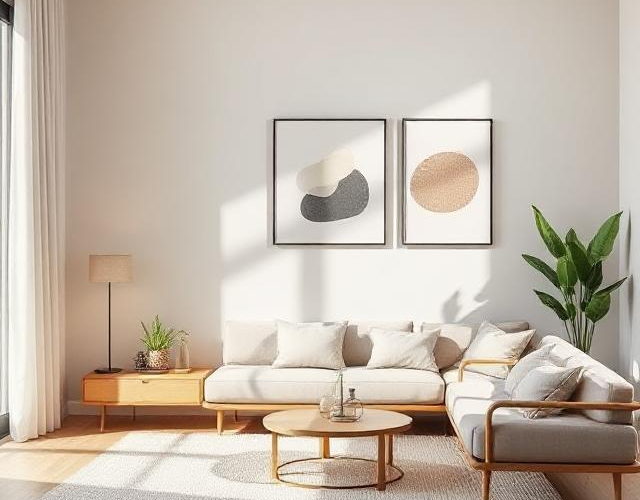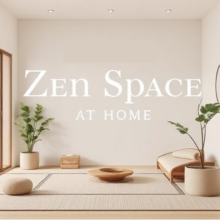The Impact of Minimalist DIY Decor on Mental Well-being

Introduction
In an era of fast-paced living and constant digital distractions, our homes should serve as sanctuaries of peace and tranquility. Yet, cluttered and chaotic environments can have the opposite effect—contributing to stress, anxiety, and cognitive overload. Enter minimalist DIY decor, a powerful approach that blends simplicity, functionality, and personal creativity to create spaces that promote mental well-being.
Minimalism is more than just an aesthetic; it is a mindset that embraces intentionality and mindfulness. When combined with DIY decor, it allows individuals to craft their own stress-free spaces, reflecting their personal style while eliminating excess. In this article, we will explore the deep connection between minimalist decor and mental well-being, backed by psychological insights and practical DIY strategies.
Understanding Minimalist DIY Decor
What is Minimalist Decor?
Minimalist decor is based on the philosophy of “less is more.” It prioritizes clean lines, open spaces, neutral colors, and functional elements while avoiding unnecessary clutter. The goal is to create an environment that fosters calmness, order, and balance.
Why DIY?
DIY (Do-It-Yourself) decor personalizes minimalism by allowing individuals to create unique, handcrafted pieces that reflect their tastes and needs. Unlike mass-produced furniture or accessories, DIY decor is more intentional and emotionally significant—which can enhance its psychological benefits.
Some key benefits of minimalist DIY decor include:
- Affordability – Save money by repurposing and upcycling materials.
- Sustainability – Reduce waste by creating decor with eco-friendly resources.
- Emotional connection – Handmade pieces carry personal meaning and sentimental value.
- Creative expression – Crafting decor fosters relaxation, joy, and mindfulness.
The Science Behind Minimalism and Mental Well-being
Scientific research shows that our surroundings have a direct impact on our emotions, cognitive function, and overall mental health.
1. Clutter and Stress: The Psychological Burden
Studies have found that excessive clutter increases cortisol levels (the stress hormone), leading to anxiety and reduced focus. A minimalist space, free from visual chaos, can significantly lower stress and create a sense of control and clarity.
💡 Example: A cluttered entryway filled with shoes, bags, and random items can make you feel overwhelmed. By designing a DIY minimalist shoe rack or storage bench, you create a cleaner, more organized space that enhances relaxation.
2. The Power of Simplicity in Cognitive Function
A streamlined and organized environment enhances cognitive performance and decision-making. When you remove unnecessary distractions, your brain can focus more effectively, improving productivity and mental clarity.
💡 Example: A DIY floating desk with concealed storage creates a workspace that encourages focus and efficiency, reducing mental fatigue.
3. The Role of Intentionality and Mindfulness
Minimalism forces individuals to be intentional about what they own and why. This mindfulness-based approach promotes:
- Gratitude for what you have
- A deeper emotional connection to personal spaces
- A reduction in impulse buying and materialistic stress
💡 Example: Instead of filling your walls with random artwork, you can paint your own abstract piece that holds personal meaning, making your space more purposeful.
Key Mental Health Benefits of Minimalist DIY Decor
1. Reduces Stress and Anxiety
A minimalist space provides a calm, uncluttered environment that soothes the mind. When everything has a place and purpose, the brain experiences less cognitive overload, reducing anxiety levels.
✅ DIY Idea: Create a neutral-toned storage solution like woven baskets or handmade wooden shelves to organize everyday essentials.
2. Enhances Focus and Productivity
A clutter-free environment allows for better concentration and fewer distractions. Whether it’s a home office or a bedroom, minimalism creates spaces optimized for productivity and rest.
✅ DIY Idea: Design a minimalist pegboard organizer to keep work essentials neatly arranged without taking up desk space.
3. Encourages Creativity and Self-Expression
DIY projects allow you to infuse personality and creativity into your home. Crafting minimalist decor encourages self-expression while maintaining the clean, cohesive look of minimalism.
✅ DIY Idea: Make a handmade linen cushion cover or a woven wall hanging to add texture and warmth to your space.
4. Improves Sleep Quality
A clutter-free, minimalist bedroom reduces overstimulation, signaling the brain that it’s time to relax. Simple, natural elements create a cozy, sleep-friendly atmosphere.
✅ DIY Idea: Build a wooden bed frame with hidden storage, or craft your own soft linen blackout curtains for a restful environment.
5. Fosters Mindfulness and Intentional Living
Choosing to design and curate your own decor pieces encourages mindfulness and thoughtful living. When you create instead of consume, you become more aware of what you truly need and value.
✅ DIY Idea: Instead of buying random home accessories, make a hand-painted ceramic vase to hold fresh flowers, bringing intentional beauty into your space.
Practical DIY Minimalist Decor Ideas for Mental Wellness
Here are simple DIY projects that blend minimalist aesthetics with emotional well-being:
🛠 DIY Floating Wooden Shelves – Provides clean storage for books and essentials.
🛠 Handmade Woven Baskets – Keeps clutter hidden while adding texture.
🛠 Minimalist Wall Art – A simple canvas with neutral brush strokes.
🛠 Natural Light Enhancers – DIY mirrors to reflect light and create openness.
🛠 Repurposed Furniture – Upcycling an old piece into a sleek, functional design.
Each of these projects supports mental clarity and relaxation while maintaining an elegant, modern aesthetic.
Balancing Minimalism and Personal Expression
One common misconception about minimalism is that it feels cold, impersonal, or restrictive. However, true minimalism is about intentionality—choosing what adds value and meaning to your space.
Tips to Maintain Minimalism While Adding Personality
✔ Use a neutral base but add warmth – Incorporate wood, linen, and soft lighting.
✔ Keep decor meaningful – Display items that evoke joy, not just for aesthetics.
✔ Layer textures – Mix natural fibers and soft textiles to create comfort.
✔ Curate personal art – Instead of mass-produced decor, craft something uniquely yours.
By striking the right balance, you create a minimalist space that feels warm, inviting, and truly “you.”
Conclusion
Minimalist DIY decor is more than a trend—it is a transformative approach to home design that enhances mental well-being. By adopting minimalist principles, incorporating handmade decor, and creating spaces with intention, you foster a calm, organized, and emotionally uplifting environment.
Are you ready to embrace the benefits of minimalist DIY decor? Start by decluttering a small area, crafting a simple decor piece, or transforming one corner of your home into a peaceful retreat.



